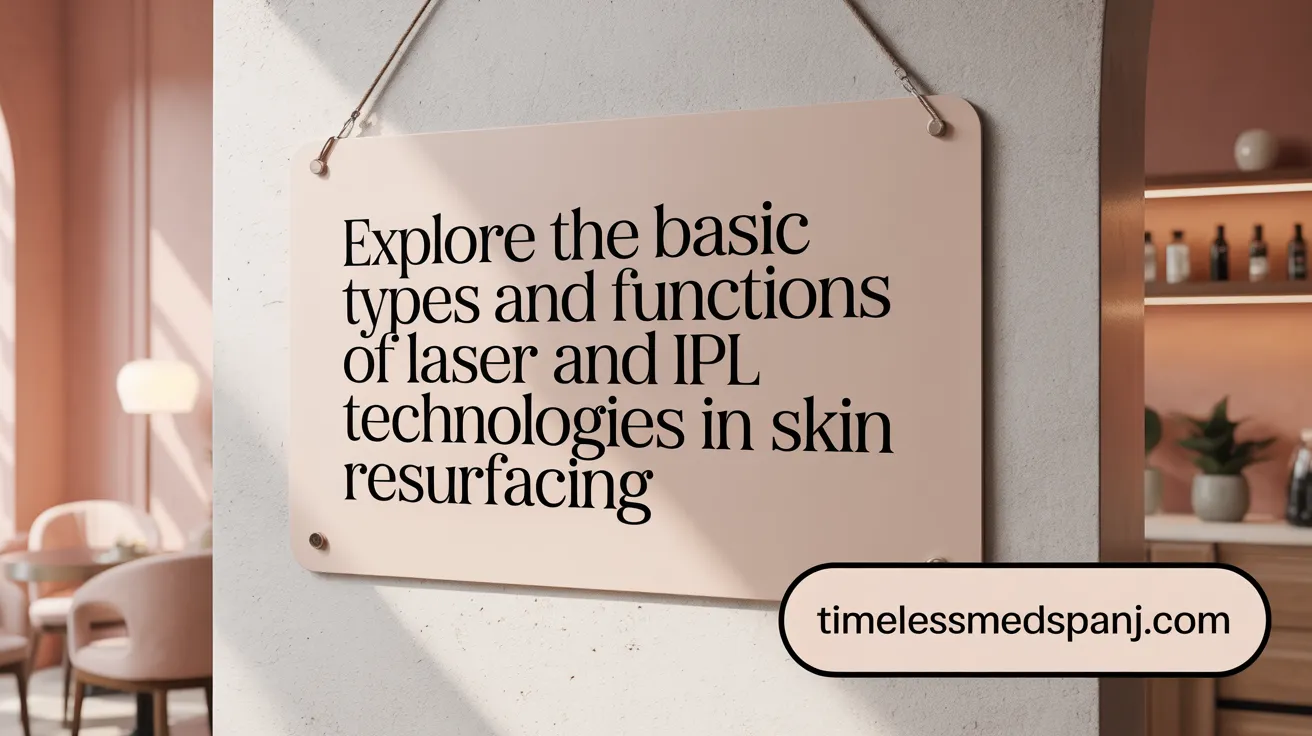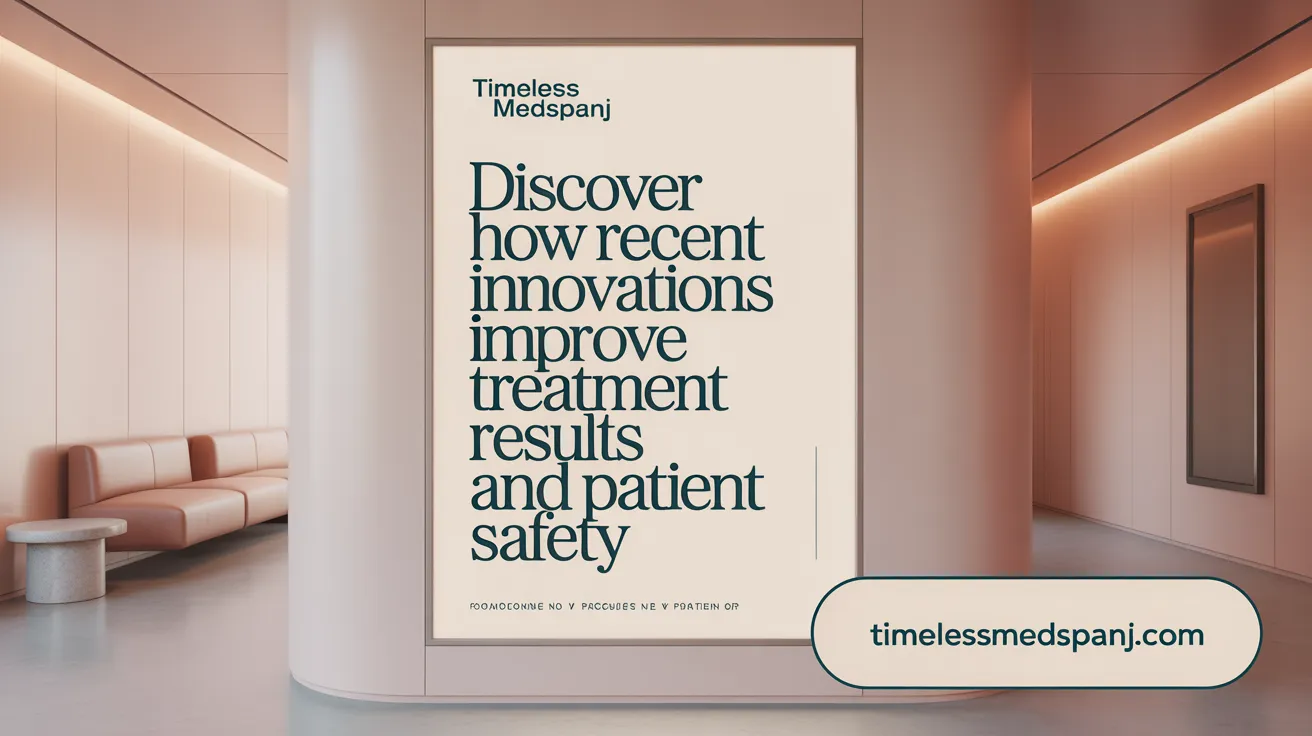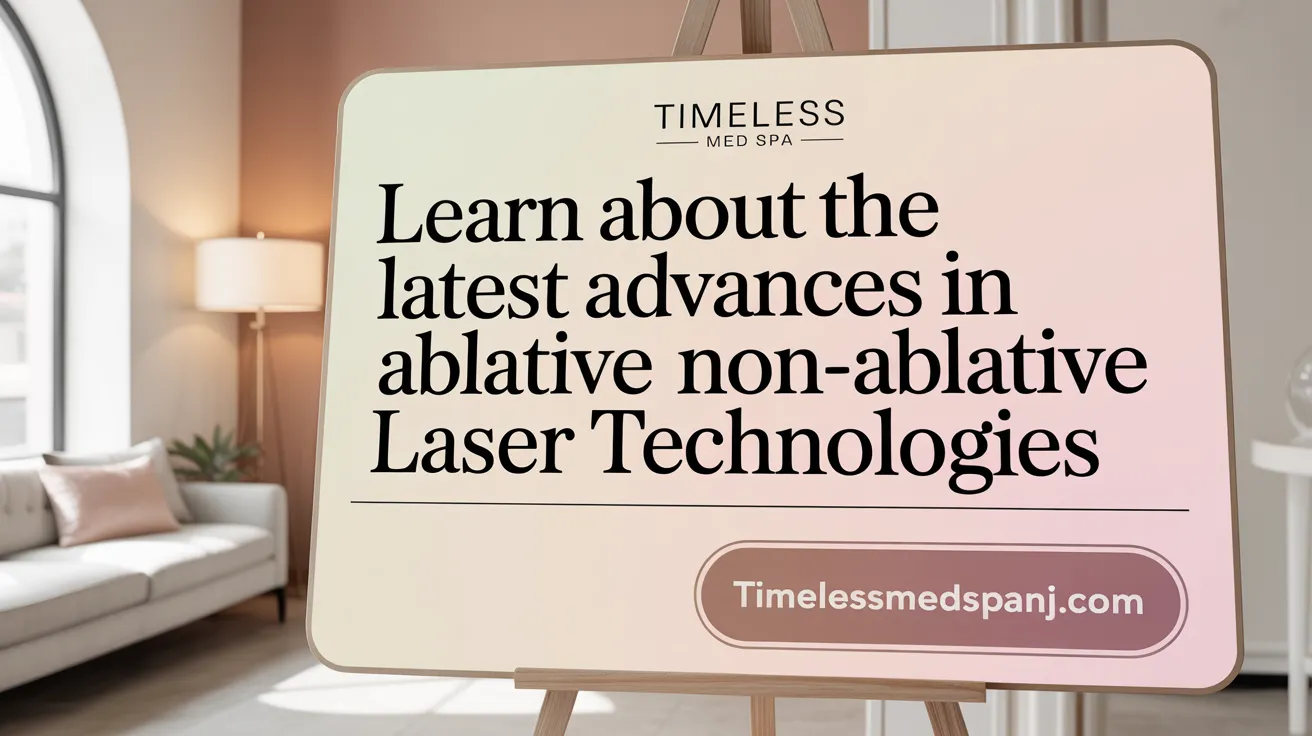Advancements Reshaping Skin Resurfacing
Skin resurfacing has witnessed remarkable innovations with the evolution of laser and Intense Pulsed Light (IPL) technologies. From traditional ablative lasers to cutting-edge AI-powered systems, these treatments offer personalized, effective, and safer options for a diverse range of skin types and concerns. This article explores the latest breakthroughs, mechanisms, and clinical applications that are transforming skin rejuvenation.
Fundamentals of Laser and IPL Skin Resurfacing Technologies

What are the basic types of laser and IPL technologies used in skin resurfacing and their primary functions?
Laser and IPL skin resurfacing utilize light-based energy to restore and enhance skin appearance by promoting collagen production and removing damaged skin layers.
Basic principles of laser and IPL skin resurfacing
Laser resurfacing uses focused light energy to precisely target skin tissues, either removing outer skin layers or heating deeper layers to stimulate natural healing responses. IPL (Intense Pulsed Light) therapy uses broad-spectrum light filtered to specific wavelengths to target skin pigments and blood vessels without ablating skin.
Key laser types and their therapeutic roles
- Ablative Lasers: Vaporize damaged skin surfaces for dramatic results. Ideal for wrinkles, scars, and severe skin damage but involve longer recovery.
- Non-Ablative Lasers: Heat the dermis beneath the skin surface to stimulate collagen without removing skin, providing moderate improvements with shorter downtime.
- Fractional Lasers: Deliver laser energy in tiny fractionated columns, treating small skin areas while preserving surrounding tissue. Available in ablative and non-ablative forms, they balance efficacy and faster healing.
IPL technology fundamentals and applications
IPL devices emit a broad range of wavelengths (typically 400–1400 nm) adjustable via filters to target specific chromophores such as melanin and hemoglobin. This versatility allows IPL to treat pigmentation disorders, vascular lesions, acne, and encourage collagen production without damaging the epidermis. The selective photothermolysis principle enables safe and effective treatment over multiple skin conditions.
Together, these technologies provide customizable options for various skin concerns based on patient needs, skin type, and desired recovery times.
Advancements in Laser Technologies Enhancing Efficacy and Safety

How have recent advancements in laser technologies improved treatment efficacy and patient safety?
Recent innovations in laser skin resurfacing have significantly boosted both the effectiveness of treatments and patient safety. One major breakthrough is the introduction of fractional laser technology. Unlike traditional ablative lasers that treat the entire skin surface, fractionated lasers target microscopic columns of skin, known as microthermal zones. This approach promotes faster healing, reduces downtime, and lowers the risk of side effects like scarring and pigmentation changes.
Hybrid laser systems have also emerged, combining ablative and non-ablative laser benefits. These systems offer the dramatic skin rejuvenation effects of ablative lasers while maintaining the gentler action and shorter recovery time typical of non-ablative lasers. Such synergy enhances treatment outcomes with less discomfort and minimized complications.
Cutting-edge treatments now often incorporate AI-powered laser devices. These smart systems analyze skin characteristics in real time and tailor their settings accordingly. This personalization ensures precise targeting of problem areas, reduces the likelihood of adverse reactions, and improves overall efficacy.
Advancements have also widened treatment applicability across diverse skin types, including darker tones traditionally at higher risk for pigmentation issues. Improved cooling technologies and refined laser parameters enable safe and effective procedures for a broader patient population.
Overall, these technological developments reduce downtime and side effects, making laser skin resurfacing safer and more accessible while delivering superior results.
Cutting-Edge Ablative and Non-Ablative Laser Modalities

What are the characteristics and innovations associated with ablative and non-ablative laser modalities?
Ablative lasers, notably the CO2 lasers and Er:YAG lasers types, remain impactful tools in skin resurfacing. CO2 lasers, operating at a wavelength of 10,600 nm, vaporize tissue deeply and stimulate collagen production, offering dramatic improvements for wrinkles and scarring but traditionally coming with extended downtime and higher risk. Er:YAG lasers, working at 2940 nm, deliver more precise ablation with substantially less thermal damage to surrounding tissues, leading to shorter recovery periods.
A significant advancement is the development of fractional ablative lasers. These devices treat only a fraction of the skin surface with microscopic columns, enhancing safety and reducing downtime without sacrificing efficacy. This fractional laser technology balances the high effectiveness of ablative methods while minimizing complications typically associated with full-surface treatments.
On the other hand, non-ablative lasers such as the 1319-nm pulsed laser, 1320-nm Nd:YAG laser, and erbium fiber lasers around 1540/1550 nm offer a gentler approach. These systems work beneath the skin surface, stimulating dermal collagen remodeling without destroying the epidermis, resulting in moderate improvements with minimal downtime. Their use is especially favorable for patients seeking rejuvenation with quicker recovery or those with concerns about side effects.
Innovations also extend to cold laser resurfacing (also known as low-level light therapy) and picosecond lasers. Cold laser resurfacing provides a non-thermal, highly gentle stimulation ideal for sensitive skin types or patients desiring no downtime. Picosecond lasers emit ultra-short pulses that target deeper and more superficial layers simultaneously. They encourage collagen production and skin tightening with less irritation and faster healing compared to traditional ablative methods.
Together, these modalities represent a spectrum of technological advances tailored to individual patient needs, balancing safety, efficacy, and recovery time in contemporary laser skin resurfacing.
Innovations in IPL Technology for Versatile Skin Treatments
How does IPL work through selective photothermolysis?
IPL (Intense Pulsed Light) therapy uses broad-spectrum light, typically ranging from 400 to 1400 nm, to target specific skin structures. It works on the principle of selective photothermolysis, where chromophores such as melanin in pigmentation and hemoglobin in blood vessels absorb the light energy. This light is converted to heat, selectively damaging these targets without harming surrounding tissues, thereby improving skin tone, reducing vascular lesions, and aiding hair removal.
What are the roles of adjustable wavelength filters and pulse parameters in IPL treatments?
IPL devices use customizable bandpass filters (e.g., 515, 550, 560, 590, 615 nm) to emit light at specific wavelengths suitable for treating various conditions. Pulse duration and pulse sequences can also be tailored to match the thermal relaxation times of different skin targets, enhancing treatment precision. This versatility allows for safe and effective management of multiple skin concerns in one device. See more on Advances in IPL technology and treatment parameters.
Which skin conditions can IPL effectively treat?
IPL can address a broad spectrum of concerns:
- Pigmentation Issues: Treats freckles, lentigines, melasma, and uneven skin tone by targeting melanin.
- Vascular Lesions: Effective for telangiectasias, rosacea, spider veins, and port wine stains by targeting hemoglobin.
- Hair Removal: Targets melanin in hair follicles to reduce unwanted hair, especially effective on dark, coarse hair.
- Skin Rejuvenation: Stimulates collagen production, improving skin texture and reducing photoaging signs like fine wrinkles.
Refer to detailed IPL skin conditions and treatments at IPL Photorejuvenation overview and Intense Pulsed Light therapy benefits.
How have recent advancements improved IPL safety and use for diverse skin tones?
Technological innovations such as higher-intensity flashlamps, advanced cooling systems, and refined cut-off filters have significantly increased IPL safety and efficacy. These improvements minimize side effects like epidermal burns, hyper-, and hypopigmentation. Current IPL devices accommodate a broader range of skin tones, including darker complexions, by adjusting parameters to reduce melanin-related risks while maintaining effectiveness. Learn more about Innovations in IPL technology and safety.
This evolving IPL technology offers a versatile, minimally invasive option for comprehensive skin treatment with minimal downtime and increased patient safety. For further reading on non-invasive skin rejuvenation technologies, see Skin rejuvenation technologies including IPL and latest laser and IPL treatments.
Integrative Approaches: Combining Laser, IPL, and Adjunct Therapies
Synergistic effects of combining CO2 lasers and Er:YAG lasers
Combining CO2 and Er:YAG lasers harnesses the strengths of both technologies to optimize skin resurfacing outcomes. CO2 lasers provide strong tissue ablation and collagen contraction, effective for deep wrinkles and scars, but carry risks like hypopigmentation. Er:YAG lasers offer precise superficial ablation with less thermal damage and quicker recovery. When used together, they balance aggressive tissue removal and controlled thermal stimulation, resulting in effective treatment with fewer side effects and reduced downtime.
IPL in conjunction with chemical peels and injectables
Intense Pulsed Light (IPL) therapy complements chemical peels by enhancing skin renewal processes and improving pigmentation, texture, and tone. This combination accelerates exfoliation and addresses signs of photoaging more comprehensively. Additionally, IPL paired with injectables like Botox and dermal fillers targets uneven skin tone and volume loss, providing a balanced, youthful appearance by smoothing wrinkles and improving blood vessel-related discolorations.
Laser-assisted drug delivery and platelet-rich plasma (PRP) applications
Laser treatments create micro-injuries in the skin that can enhance topical drug penetration. This laser-assisted delivery improves efficacy for conditions like actinic keratoses and pigmentation disorders. Pairing lasers with platelet-rich plasma (PRP) promotes faster wound healing and collagen remodeling. PRP delivers concentrated growth factors post-laser treatment, reducing recovery time and improving skin texture and tightness.
Radiofrequency (RF) treatments alongside lasers
Radiofrequency systems apply thermal energy to deeper skin layers and subcutaneous tissues, stimulating collagen remodeling and skin tightening with minimal pigmentary risks. When combined with laser therapies, RF treatments offer a holistic rejuvenation effect by addressing skin laxity that lasers alone may not fully correct. This integrative use enhances overall skin tone, firmness, and texture for long-lasting results.
What benefits do combination therapies involving lasers, IPL, and adjunct treatments offer?
Combination therapies harness the unique mechanisms of each modality to maximize skin improvement while minimizing side effects and recovery time. The synergy between ablative lasers like CO2 lasers and Er:YAG lasers balances depth and precision for effective resurfacing. IPL’s versatility enhances pigmentation and vascular treatment outcomes when paired with chemical peels or injectables. Laser-assisted drug delivery and PRP accelerate healing and collagen production post-treatment. Incorporating radiofrequency (RF) treatments expands therapeutic effects to deeper tissues for comprehensive rejuvenation. Altogether, these integrated approaches provide tailored, effective, and safer skin resurfacing solutions.
Personalized Treatment Selection Based on Skin Type and Concerns
How are laser resurfacing and IPL treatments personalized to suit different skin types and specific concerns?
In modern skin resurfacing, personalized treatment plans are crucial to achieving optimal results while minimizing risks. The choice of laser or IPL therapy depends largely on the patient's skin type, the severity of wrinkles, scars, pigmentation concerns, and their personal treatment goals.
Ablative lasers, such as CO2 lasers and Er:YAG lasers, are ideal for treating severe wrinkles, deep scars, and marked sun damage. However, they require longer recovery due to their aggressive nature. For those seeking moderate improvements with minimal downtime, non-ablative lasers stimulate collagen beneath the skin surface without damaging the epidermis, proving effective for fine wrinkles and mild pigmentation issues.
Fractional laser technology offers a balanced approach by treating microscopic skin zones, promoting faster healing and reducing side effects. This method is safe and efficacious across a range of skin tones, including darker complexions, addressing pigmentation, texture irregularities, and mild scarring.
IPL treatments use broad-spectrum light to target pigment and vascular concerns with minimal invasiveness. They are especially beneficial for conditions like age spots, rosacea, and uneven tone.
Recent advances in AI-powered lasers and enhanced fractional systems allow real-time skin assessment and adjustment during procedures, tailoring treatment depth, energy levels, and wavelengths. These innovations increase safety and effectiveness, catering to diverse skin types and complex conditions for truly personalized care.
Managing Treatment Preparation, Procedure, and Recovery
What are key considerations for preparation, procedural conduct, and recovery management in laser resurfacing and IPL resurfacing?
Proper preparation is essential for successful laser resurfacing treatments and Intense Pulsed Light (IPL) therapy outcomes. Prior to treatment, a thorough medical history review and physical skin examination are conducted to assess suitability. Patients are screened for conditions like active herpes or photosensitivity, which may require pre-treatment antiviral medication or delay. Avoiding tanning and smoking is recommended, as both can increase risks of complications and hinder healing. Patients are also advised to discontinue certain medications, such as blood thinners, to prevent bleeding or bruising.
Procedures are generally outpatient and last between 30 minutes to two hours depending on the treated area and device used. Local anesthesia or sedation is commonly employed to manage discomfort, especially during ablative laser resurfacing treatments. The use of advanced systems, including fractional lasers or IPL, allows precise targeting with minimal trauma to surrounding skin.
Post-treatment care focuses on protecting and supporting the healing skin. This includes applying prescribed ointments or dressings, keeping skin moisturized, and avoiding direct sun exposure with high-SPF sunscreen. Patients may experience redness, swelling, or mild itching, typically resolving within days to weeks. Recovery time varies with the treatment type; ablative lasers often require longer healing periods, while nonablative and IPL treatments have minimal downtime. Follow-up with the provider ensures monitoring for side effects and proper healing.
Risks such as hyperpigmentation, hypopigmentation, infections, or scarring are mitigated by proper patient selection, skilled practitioner technique, and adherence to post-care instructions. Preventative measures, including antiviral prophylaxis and sun avoidance, further reduce complications. Overall, comprehensive preparation, precise procedural conduct, and diligent aftercare optimize safety and clinical results in laser and IPL skin resurfacing.
Future Perspectives: Emerging Technologies and Trends in Skin Resurfacing
What future trends and technologies are shaping next-generation laser and IPL skin resurfacing?
The future of skin resurfacing is being revolutionized by artificial intelligence (AI)-driven laser systems. These advanced lasers feature real-time skin analysis capabilities, enabling personalized adjustments during treatment. This innovation enhances precision, safety, and outcomes by tailoring energy delivery to individual skin conditions as the procedure unfolds.
Cold laser therapy, also known as low-level light therapy, represents a gentler, non-thermal approach ideal for sensitive skin and patients seeking zero downtime. Picosecond lasers, delivering ultra-short pulse bursts, offer effective treatment for pigmentation issues and skin rejuvenation with minimal discomfort and fast recovery.
Another significant trend is the advent of multifunctional devices that combine laser, Intense Pulsed Light (IPL), and radiofrequency (RF) technologies . These integrated platforms provide comprehensive and customizable treatments in a single session, improving convenience and efficacy.
Accessibility and inclusivity are expanding with safer protocols for darker skin tones and diverse age groups. Advancements in technology have permitted tailored approaches that minimize risks of pigmentation changes. Additionally, at-home laser and light-based devices are emerging, allowing safe and effective maintenance treatments beyond clinical settings.
Together, these innovations are shaping a more personalized, inclusive, and versatile landscape for skin resurfacing treatments, promising enhanced patient experiences and results.
Clinical Evidence and Safety Profiles Underpinning Modern Laser and IPL Treatments
What does clinical evidence reveal about the efficacy and safety of modern laser and IPL skin resurfacing treatments?
Extensive clinical research has verified the effectiveness of various laser resurfacing technologies—including fractionated lasers, ablative lasers, and non-ablative lasers—as well as Intense Pulsed Light (IPL) in enhancing skin texture, pigmentation, and stimulating collagen production. These advanced therapies deliver significant skin rejuvenation technologies, addressing issues such as wrinkles, scars, uneven tone, and dyspigmentation.
How does practitioner skill and patient selection influence treatment outcomes?
The success and safety of laser and IPL treatments greatly depend on the expertise of the practitioner and careful patient selection. Experienced clinicians tailor treatments to individual skin types and concerns, minimizing risks like hyperpigmentation, hypopigmentation, scarring, and infections. Assessment of patient medical history and skin characteristics informs optimal treatment choices, improving both outcomes and satisfaction.
What advances have been made to improve safety and reduce adverse effects?
Technological developments—such as fractional laser technology, hybrid laser technology, and enhanced cooling mechanisms—have substantially lowered complication rates. Modern lasers provide controlled energy targeting, preserving surrounding tissue and reducing downtime. Similarly, IPL devices have been optimized to provide customizable wavelength ranges and pulse durations, further enhancing safety, especially for darker skin tones.
What are the long-term outcomes and maintenance considerations?
Laser and IPL treatments offer lasting improvements in skin appearance, commonly sustaining effects for several years. However, ongoing maintenance treatments combined with sun protection and skincare regimens are essential to prolong benefits and prevent photoaging. Continued innovation and personalized approaches ensure sustained skin health and patient satisfaction.
A New Horizon in Skin Resurfacing Excellence
Innovations in laser and IPL technologies have revolutionized skin resurfacing, offering safer, more effective, and personalized treatments that cater to diverse skin types and conditions. Advanced fractional, hybrid, and AI-driven systems have minimized downtime and risks while maximizing rejuvenation outcomes. The integration of combination therapies and emerging modalities promises further clinical breakthroughs. As technology progresses, individualized treatment plans empowered by scientific evidence ensure that patients achieve optimal results, redefining the future of aesthetic dermatology.
